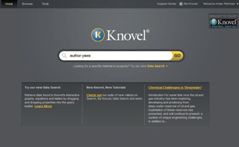Knovel launches new platform following Elsevier's purchase
Earlier this year Elsevier bought the web-based engineering information company Knovel. Siân Harris caught up with what the company has been doing since it was bought, and how things have changed

When news breaks of a new acquisition it’s easy to assume that this is a very recent development. In the case of Elsevier’s purchase of Knovel earlier this year, however, Elsevier’s Ella Balagula admits that she began championing the company’s acquisition in 2007 when she first met Knovel’s then president and CEO, Chris Forbes.
Six years on and the engineering information company has now become part of the publishing giant and Balagula herself is now Knovel’s acting CEO, as well as senior vice president, engineering & technology markets at Elsevier. ‘We are really excited about this acquisition and the progress Knovel has made since joining Elsevier,’ she said.
Knovel was founded in 2001 with the aim of ‘integrating technical information with analytical and search tools to drive innovation and deliver answers engineers can trust’. Its approach is to take information from books from more than 100 engineering societies and publishers and present relevant portions of information in response to engineers’ searches. One of its key features is the ability for engineers to input their own data into equations.
A new platform
Before the company was bought by Elsevier in early January work was already underway on a new platform for Knovel and that new platform was launched this September. It promises more precise search results, a simplified user interface and enhanced navigation capabilities.
‘Search algorithms have been redefined to make answers more discoverable. It’s Google-like when it opens but gets very deep, very quick,’ said Balagula. ‘The old platform was very much e-book centric; the new one is answer centric. It is in the language that engineers think.’
She said that the interactive equations feature has also been enhanced in the new platform and that the number of interactive objects is increasing by 25 per cent this year. ‘Equations are at the core of what Knovel does. Answers are trusted, discoverable and actionable, and users can embed them into their workflows.’
The acquisition had an impact on the development of the platform. According to Balagula, ‘developments have been very much Knovel led’ but being part of Elsevier has brought advantages. In particular, Elsevier has, of course, got deeper pockets than Knovel had and has plenty of other developments and expertise to draw on.

‘I think the foundation of what Knovel did was done fantastically well. They invested for years into user-centred design. We didn’t change the underlying approach but were able to parachute in much more resources,’ she explained. ‘We want to bring in more standardisation without stifling innovation.’
This resulted, she said, is a more long-term approach to development. ‘As a very large company we put more rigour into development and testing and built the architecture for the longer term. At ground level, the platform was built with the ability to connect with other products through the API.’ For example, the platform will allow users to plug information into their CAD software. ‘People become more and more tool agnostic and want to move seamlessly between tools,’ she said.
She sees enabling sharing and collaboration as an important opportunity too. ‘Through the API we are looking to connect to internal systems,’ she said, noting that the company is doing a pilot with some customers to connect to people’s SharePoint. Eventually, she said, the platform could have an open API.
Content opportunities
Another aspect of the development is content. ‘The Elsevier acquisition brings much broader reach. We continuously add more content,’ said Balagula.
Knovel has had a partnership with Elsevier for a long time for Elsevier’s e-book content. However Balagula says the acquisition brings opportunities to work together more closely and also bring in more content types such as journals and patents. In addition there will be opportunities to work with content from another of Elsevier’s recent acquisitions, Woodhead Publishing.
There are also potential opportunities with Elsevier’s databases. One possibility, which she said the company is researching at the moment, is how Knovel might work with Elsevier’s Engineering Village. ‘Engineering Village answers research questions. At the design stage engineers go to Knovel. We are evaluating the need for these products to work together.’
Another example that the company is looking at is possibilities to bring in content from Elsevier’s Reaxys database, which provides chemists – and chemical engineers – with detailed information about chemical compounds.

Ella Balagula
This type of opportunity fits with another area of development for Knovel, the concept of personas.
‘Engineers are different from each other and their needs are very different. We’ve identified some key personas and we will prioritise development based on these,’ she explained. The first personas being studied are: mechanical engineering in engineering construction and design; aerospace; and chemical engineering with speciality chemicals.
Merging cultures
One of the things that is always a concern with any acquisition is how the cultures of the two companies will work together. Balagula noted that Knovel has a different working style from Elsevier and she was keen not to lose this. ‘One of the things I wanted to retain was Knovel operating separately so we have kept the Knovel office in New York and are keeping the culture,’ she said. Many of the people are the same, although Chris Forbes is no longer involved in the day-to-day running of the company. ‘He is passionate about Knovel’s future. He sits on the company’s advisory board and we talk often,’ she said.
Balagula noted that the two companies’ cultures have gelled well together. ‘People see lots of opportunities with the acquisition by a large company and it’s surprised me how well that’s gone,’ she said. ‘Even though we are a traditional publisher we are setting up technology businesses. The Mendeley acquisition took a very similar approach. We are extremely excited about collaboration opportunity that it brings.’






